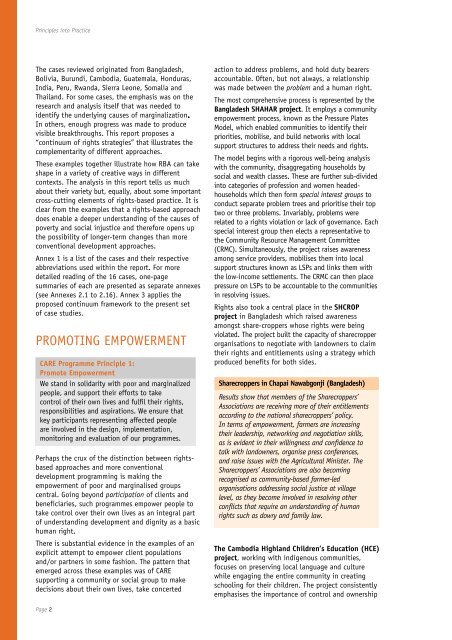Principles into Practice - Handicap International
Principles into Practice - Handicap International
Principles into Practice - Handicap International
- No tags were found...
Create successful ePaper yourself
Turn your PDF publications into a flip-book with our unique Google optimized e-Paper software.
<strong>Principles</strong> <strong>into</strong> <strong>Practice</strong>The cases reviewed originated from Bangladesh,Bolivia, Burundi, Cambodia, Guatemala, Honduras,India, Peru, Rwanda, Sierra Leone, Somalia andThailand. For some cases, the emphasis was on theresearch and analysis itself that was needed toidentify the underlying causes of marginalization.In others, enough progress was made to producevisible breakthroughs. This report proposes a“continuum of rights strategies” that illustrates thecomplementarity of different approaches.These examples together illustrate how RBA can takeshape in a variety of creative ways in differentcontexts. The analysis in this report tells us muchabout their variety but, equally, about some importantcross-cutting elements of rights-based practice. It isclear from the examples that a rights-based approachdoes enable a deeper understanding of the causes ofpoverty and social injustice and therefore opens upthe possibility of longer-term changes than moreconventional development approaches.Annex 1 is a list of the cases and their respectiveabbreviations used within the report. For moredetailed reading of the 16 cases, one-pagesummaries of each are presented as separate annexes(see Annexes 2.1 to 2.16). Annex 3 applies theproposed continuum framework to the present setof case studies.PROMOTING EMPOWERMENTCARE Programme Principle 1:Promote EmpowermentWe stand in solidarity with poor and marginalizedpeople, and support their efforts to takecontrol of their own lives and fulfil their rights,responsibilities and aspirations. We ensure thatkey participants representing affected peopleare involved in the design, implementation,monitoring and evaluation of our programmes.Perhaps the crux of the distinction between rightsbasedapproaches and more conventionaldevelopment programming is making theempowerment of poor and marginalised groupscentral. Going beyond participation of clients andbeneficiaries, such programmes empower people totake control over their own lives as an integral partof understanding development and dignity as a basichuman right.There is substantial evidence in the examples of anexplicit attempt to empower client populationsand/or partners in some fashion. The pattern thatemerged across these examples was of CAREsupporting a community or social group to makedecisions about their own lives, take concertedaction to address problems, and hold duty bearersaccountable. Often, but not always, a relationshipwas made between the problem and a human right.The most comprehensive process is represented by theBangladesh SHAHAR project. It employs a communityempowerment process, known as the Pressure PlatesModel, which enabled communities to identify theirpriorities, mobilise, and build networks with localsupport structures to address their needs and rights.The model begins with a rigorous well-being analysiswith the community, disaggregating households bysocial and wealth classes. These are further sub-divided<strong>into</strong> categories of profession and women headedhouseholdswhich then form special interest groups toconduct separate problem trees and prioritise their toptwo or three problems. Invariably, problems wererelated to a rights violation or lack of governance. Eachspecial interest group then elects a representative tothe Community Resource Management Committee(CRMC). Simultaneously, the project raises awarenessamong service providers, mobilises them <strong>into</strong> localsupport structures known as LSPs and links them withthe low-income settlements. The CRMC can then placepressure on LSPs to be accountable to the communitiesin resolving issues.Rights also took a central place in the SHCROPproject in Bangladesh which raised awarenessamongst share-croppers whose rights were beingviolated. The project built the capacity of sharecropperorganisations to negotiate with landowners to claimtheir rights and entitlements using a strategy whichproduced benefits for both sides.Sharecroppers in Chapai Nawabgonji (Bangladesh)Results show that members of the Sharecroppers’Associations are receiving more of their entitlementsaccording to the national sharecroppers’ policy.In terms of empowerment, farmers are increasingtheir leadership, networking and negotiation skills,as is evident in their willingness and confidence totalk with landowners, organise press conferences,and raise issues with the Agricultural Minister. TheSharecroppers’ Associations are also becomingrecognised as community-based farmer-ledorganisations addressing social justice at villagelevel, as they become involved in resolving otherconflicts that require an understanding of humanrights such as dowry and family law.The Cambodia Highland Children’s Education (HCE)project, working with indigenous communities,focuses on preserving local language and culturewhile engaging the entire community in creatingschooling for their children. The project consistentlyemphasises the importance of control and ownershipPage 2

















